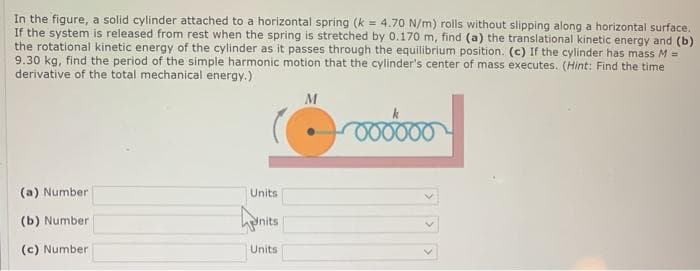In the figure, a solid cylinder attached to a horizontal spring (k = 4.70 N/m) rolls without slipping along a horizontal surface. If the system is released from rest when the spring is stretched by 0.170 m, find (a) the translational kinetic energy and (b) the rotational kinetic energy of the cylinder as it passes through the equilibrium position. (c) If the cylinder has mass M= 9.30 kg, find the period of the simple harmonic motion that the cylinder's center of mass executes. (Hint: Find the time derivative of the total mechanical energy.)
In the figure, a solid cylinder attached to a horizontal spring (k = 4.70 N/m) rolls without slipping along a horizontal surface. If the system is released from rest when the spring is stretched by 0.170 m, find (a) the translational kinetic energy and (b) the rotational kinetic energy of the cylinder as it passes through the equilibrium position. (c) If the cylinder has mass M= 9.30 kg, find the period of the simple harmonic motion that the cylinder's center of mass executes. (Hint: Find the time derivative of the total mechanical energy.)
Principles of Physics: A Calculus-Based Text
5th Edition
ISBN:9781133104261
Author:Raymond A. Serway, John W. Jewett
Publisher:Raymond A. Serway, John W. Jewett
Chapter10: Rotational Motion
Section: Chapter Questions
Problem 78P: Review. A string is wound around a uniform disk of radius R and mass M. The disk is released from...
Related questions
Question

Transcribed Image Text:In the figure, a solid cylinder attached to a horizontal spring (k = 4.70 N/m) rolls without slipping along a horizontal surface.
If the system is released from rest when the spring is stretched by 0.170 m, find (a) the translational kinetic energy and (b)
the rotational kinetic energy of the cylinder as it passes through the equilibrium position. (c) If the cylinder has mass M =
9.30 kg, find the period of the simple harmonic motion that the cylinder's center of mass executes. (Hint: Find the time
derivative of the total mechanical energy.)
M
(a) Number
Units
(b) Number
Inits
(c) Number
Units
Expert Solution
This question has been solved!
Explore an expertly crafted, step-by-step solution for a thorough understanding of key concepts.
This is a popular solution!
Trending now
This is a popular solution!
Step by step
Solved in 4 steps

Knowledge Booster
Learn more about
Need a deep-dive on the concept behind this application? Look no further. Learn more about this topic, physics and related others by exploring similar questions and additional content below.Recommended textbooks for you

Principles of Physics: A Calculus-Based Text
Physics
ISBN:
9781133104261
Author:
Raymond A. Serway, John W. Jewett
Publisher:
Cengage Learning

Physics for Scientists and Engineers: Foundations…
Physics
ISBN:
9781133939146
Author:
Katz, Debora M.
Publisher:
Cengage Learning

Physics for Scientists and Engineers
Physics
ISBN:
9781337553278
Author:
Raymond A. Serway, John W. Jewett
Publisher:
Cengage Learning

Principles of Physics: A Calculus-Based Text
Physics
ISBN:
9781133104261
Author:
Raymond A. Serway, John W. Jewett
Publisher:
Cengage Learning

Physics for Scientists and Engineers: Foundations…
Physics
ISBN:
9781133939146
Author:
Katz, Debora M.
Publisher:
Cengage Learning

Physics for Scientists and Engineers
Physics
ISBN:
9781337553278
Author:
Raymond A. Serway, John W. Jewett
Publisher:
Cengage Learning

Physics for Scientists and Engineers with Modern …
Physics
ISBN:
9781337553292
Author:
Raymond A. Serway, John W. Jewett
Publisher:
Cengage Learning

Physics for Scientists and Engineers, Technology …
Physics
ISBN:
9781305116399
Author:
Raymond A. Serway, John W. Jewett
Publisher:
Cengage Learning

Classical Dynamics of Particles and Systems
Physics
ISBN:
9780534408961
Author:
Stephen T. Thornton, Jerry B. Marion
Publisher:
Cengage Learning